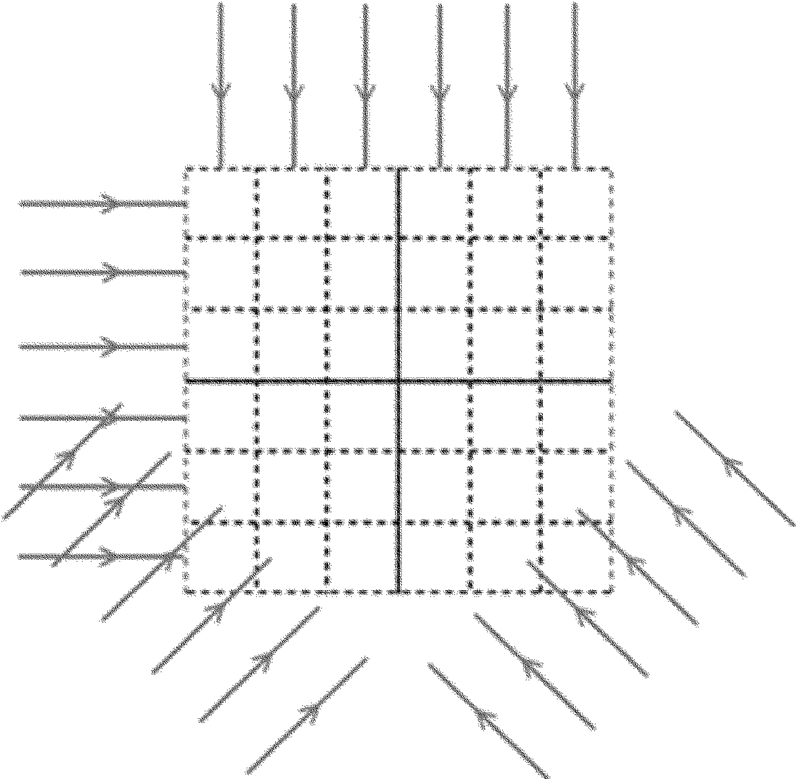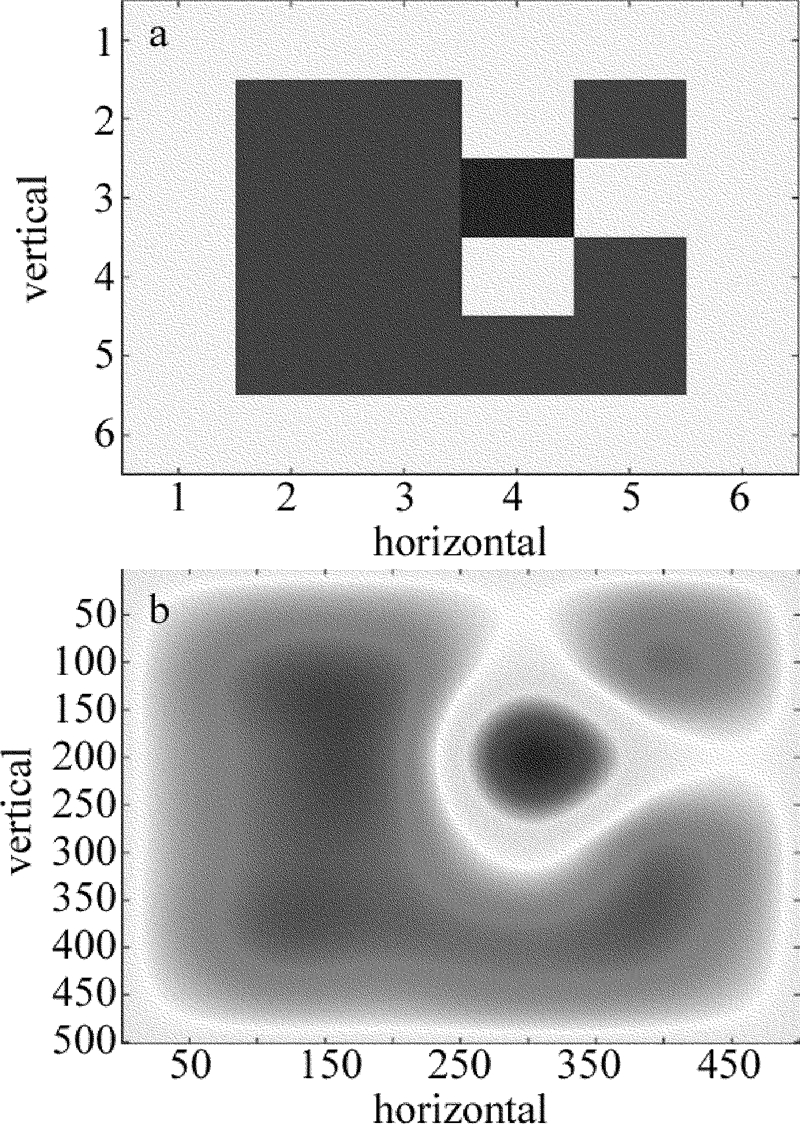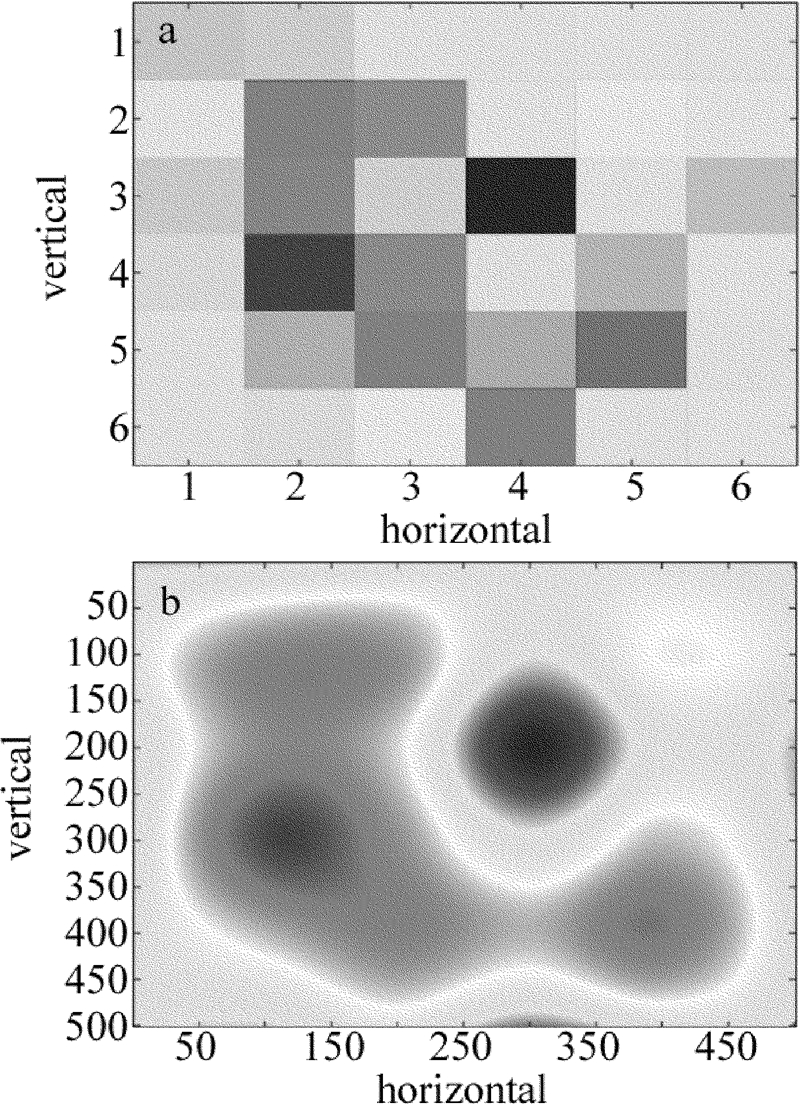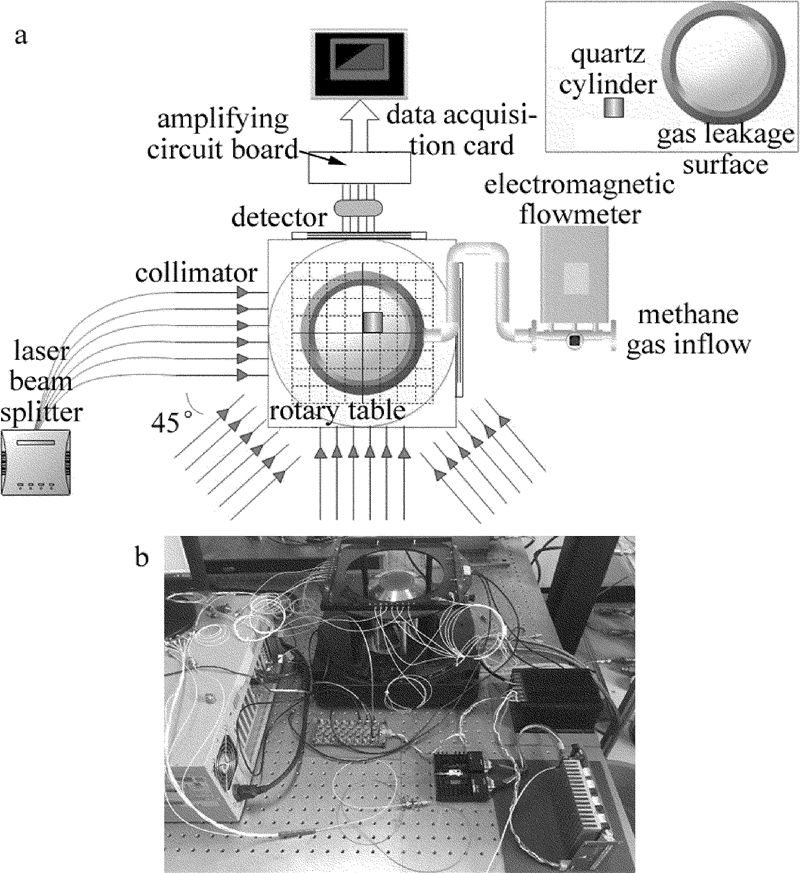Research of methane volume fraction field reconstruction based on tunable diode laser absorption spectroscopy detection technology
-
摘要: 为了实现对甲烷体积分数场的2维分布重建,基于可调谐半导体激光吸收光谱(TDLAS)检测技术,以甲烷为目标气体,采用直接吸收的测量方式,探测了甲烷氮气混合气的吸收光谱信号,通过代数重建算法对甲烷体积分数进行了模拟重建和实验研究,模拟重建采用了6×6共36个方格的正方形重建区域,假定一个方形区域内具有空穴的体积分数分布,模拟24条光束从4个方向穿过重建区域,获取了模拟光线下的投影值。结果表明,经过重复实验统计均方根误差在2.58%,对模拟投影信号加入不同信噪比(5%,10%,20%)的高斯白噪声之后再进行重建,均方根误差分别在4.17%~9.30%之间;实验研究采取面源泄露式扩散方式,并通过在中心附近放置石英柱的方式人为制造体积分数空穴,形成非均匀体积分数场,通过对放置障碍物前后的重建结果对比,能够看到在空穴位置有明显的体积分数下降。TDLAS技术与计算机断层重建技术在气体体积分数场的局部分布检测上有可行性,具备作为有毒有害气体云团体积分数分布检测手段的潜力。
-
关键词:
- 光谱学 /
- 2维分布重建 /
- 代数重建算法 /
- 可调谐半导体激光吸收光谱检测技术
Abstract: In order to realize 2-D distribution reconstruction of methane volume fraction field, based on tunable diode laser absorption spectroscopy (TDLAS) detection technology, methane was used as the target gas and the absorption spectrum signal of methane and nitrogen mixture was detected by direct absorption method. Volume fraction of methane was simulated and reconstructed by algebraic reconstruction algorithm. During simulation reconstruction, square reconstruction area with total 36 squares of 6×6 was used. By assuming volume fraction of a hole in a square area and simulating 24 beams through the reconstruction region from 4 directions, the projection values under the simulated ray were obtained. The results show that root mean square error of the repeated experiment is 2.58%. After adding Gaussian white noise with different signal-to-noise ratio (5%, 10%, 20%) to the simulated projection signal, root mean square error is between 4.17%~9.30%. Surface source leakage diffusion was adopted in the experiments. Artificial volume fraction hole was created and inhomogeneous volume fraction field was formed after quartz a column was placed near the center. By comparing the reconstruction results before and after the placement of quartz column, it can be seen that there is significant decrease of volume fraction in hole position. It is feasible to detect local distribution of gas volume fraction by TDLAS technology and computer tomography, and has the potential to detect volume fraction of toxic and harmful gas clouds. -
-
volume fraction of methane 0 0.0002613 0.002157 0 0.003408 0 volume fraction distribution of Fig. 7a 1.199×10-6 0.01037 0 0.003102 1.638×10-6 0 0.005740 0 0.01137 0.0006311 0 0 1.382×10-6 0.0009636 0.006911 0 0.0006864 0.002332 3.653×10-6 0.004569 0 0.002429 0.0001081 0.001578 0.005721 3.653×10-6 1.382×10-6 0 0.001555 0.0004072 volume fraction of methane 0.0002642 0.0002642 0.0002642 0.007122 0.01247 0.007085 volume fraction distribution of Fig. 7b 0.01339 0 0 0.006233 0.006762 0 0.003168 0.01182 0.01704 0.01841 0 0.004573 0.01162 0.01373 0.004707 0 0 0.005895 0.005415 3.391×10-5 0 0.0003252 0.008037 0 0 3.610×10-5 0.01378 9.827×10-5 0 0 -
[1] LAI S L, WANG H, GONG P, et al. Research of propane detecting based on near-infrared laser spectral absorption[J]. Laser Technology, 2017, 41(2):284-288(in Chinese). http://www.jgjs.net.cn/EN/Y2017/V41/I2/284
[2] KRISHNA Y, O'BYRNE S. Tunable diode laser absorption spectroscopy as a flow diagnostic tool:A reviewreview[J]. Journal of the Indian Institute of Science, 2016, 96(1):17-28. http://www.uianet.org/es/node/15998
[3] NADIR Z, BROWN M S, COMER M L, et al. Gaussian mixture prior models for imaging of flow cross sections from sparse hyperspectral measurements[C/OL].(2015-12-16)[2018-02-01].https://www.researchgate.net/publication/300413419_Gaussian_mixture_prior_models_for_imaging_of_flow_cross_sections_from_sparse_hyperspectral_measurements.
[4] LINDSTROM C, TAM C J, DAVIS D, et al. Diode laser absorption tomography of two dimensional supersonic flow[C/OL].(2007-07-11)[2018-02-01].https://www.researchgate.net/publication/268482107_Diode_Laser_Absorption_Tomography_of_Two_Dimensional_Supersonic_Flow.
[5] MASTERSON B, SAPPEY A, OWENBY D, et al. Flight-ready TDLAS combustion sensor for hypersonics[C/OL].(2007-07-11)[2018-02-01].https://www.researchgate.net/publication/271366737_Flight-Ready_TDLAS_Combustion_Sensor_for_Hypersonics.
[6] BRYNER E, BUSA K, MCDANIEL J, et al. Spatially resolved temperature and water vapor concentration distributions in a flat flame burner by tunable diode laser absorption tomography[C/OL].(2011-01-07)[2018-02-01]. http://www.researchgate.net/publication/268566152_Spatially_Resolved_Temperature_and_Water_Vapor_Concentration_Distributions_in_a_Flat_Flame_Burner_by_Tunable_Diode_Laser_Absorption_Tomography.
[7] DONG L, TITTEL F K, LI C, et al. Compact TDLAS based sensor design using interband cascade lasers for mid-IR trace gas sensing[J]. Optics Express, 2016, 24(6):A528-A535. DOI: 10.1364/OE.24.00A528
[8] DING N, ZHANG S B. Water vapor tomography algebraic reconstruction algorithm based on the prime number decomposition access order[J]. Geography and Geo-Information Science, 2017, 112(3):42-47. http://www.en.cnki.com.cn/Article_en/CJFDTOTAL-DLGT201703008.htm
[9] JIANG Zh Sh, WANG F, XU T, et al. Study of methane telemetry based on tunable semiconductor laser absorption spectroscopy[J]. Energy Engineering, 2012(3):5-9(in Chinese).
[10] MA L, LI X, CAI W, et al. Selection of multiple optimal absorption transitions for nonuniform temperature sensing[J]. Applied Spectroscopy, 2010, 64(11):1274-1282. DOI: 10.1366/000370210793335052
[11] BUSA K M, RICE B, MCDANIEL J C, et al. Direct measurement of combustion efficiency of a dual-mode scramjet via TDLAT and SPIV (Invited)[C/OL].(2015-01-09)[2018-02-01].http://www.researchgate.net/publication/306033342_Direct_Measurement_of_Combustion_Efficiency_of_a_Dual-Mode_Scramjet_via_TDLAT_and_SPIV_Invited.
[12] LIU C, XU L, CHEN J, et al. Development of a fan-beam TDLAS-based tomographic sensor for rapid imaging of temperature and gas concentration[J]. Optics Express, 2015, 23(17):22494. DOI: 10.1364/OE.23.022494
[13] LI J Y. Study on temperature measurement of combustion field based on tunable laser absorption spectroscopy[D]. Tianjin: Tianjin University, 2013: 1-135(in Chinese).
[14] SONG J L, HONG Y J, WANG G Y, et al. Study on two-dimensional distribution reconstruction of gas temperature and concentration in combustion field based on laser absorption spectroscopy[J]. Acta Physica Sinica, 2012, 61(24):240702(in Chinese).
[15] CHENG L H. Study of iterative tomography algorithm for gas diffusion and distribution reconstruction based on incomplete projection data[D]. Hefei: Hefei Polytechnic University, 2015: 1-78(in Chin-ese).
[16] XIA H H, KAN R F, LIU J G, et al. Analysis of algebraic reconstruction technique for accurate imaging of gas temperature and concentration based on tunable diode laser absorption spectroscopy[J]. Chinese Physics, 2016, B25(6):246-253. http://www.cqvip.com/QK/85823A/201606/668973475.html
[17] BUSA K M, BROWN M S, GRUBER M, et al. Common-path measurement of H2O, CO, and CO2 via TDLAS for combustion progress in a hydrocarbon-fueled scramjet[C/OL].(2016-01-08)[2018-02-01].http://www.researchgate.net/publication/309339754_Common-Path_Measurement_of_H2O_CO_and_CO2_via_TDLAS_for_Combustion_Progress_in_a_Hydrocarbon-Fueled_Scramjet.
[18] XIA H, XU Z, KAN R, et al. Numerical study of two-dimensional water vapor concentration and temperature distribution of combustion zones using tunable diode laser absorption tomography[J]. Infrared Physics & Technology, 2015, 72:170-178. http://www.sciencedirect.com/science/article/pii/S1350449515001681
[19] ZHANG G, LIU J, XU Z, et al. Characterization of temperature non-uniformity over a premixed CH4-air flame based on line-of-sight TDLAS[J]. Applied Physics, 2016, B122(1):3-11. http://www.irgrid.ac.cn/handle/1471x/1476676?mode=full&submit_simple=Show+full+item+record
[20] JACKSON K, GRUBER M, BARHORST T. The HIFiRE flight 2 experiment: an overview and status update[C/OL].(2009-08-05)[2018-02-01]. http://www.researchgate.net/publication/268482795_The_HIFiRE_Flight_2_Experiment_An_Overview_and_Status_Update.




 下载:
下载:





